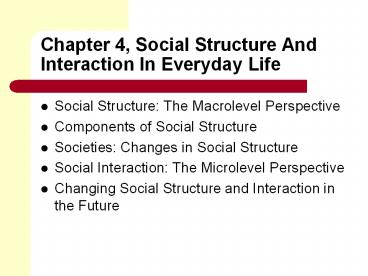Chapter 4, Social Structure And Interaction In Everyday Life PowerPoint PPT Presentation
Title: Chapter 4, Social Structure And Interaction In Everyday Life
1
Chapter 4, Social Structure And Interaction In
Everyday Life
- Social Structure The Macrolevel Perspective
- Components of Social Structure
- Societies Changes in Social Structure
- Social Interaction The Microlevel Perspective
- Changing Social Structure and Interaction in the
Future
2
Social Structure
- Patterns of social relationships in a society
make up its social structure. - Social structure shapes the overall patterns in
which social interaction occurs. - Provides an ordered framework for society and for
interactions with others.
3
Components of Social Structure
- Status
- Roles
- Groups
- Social Institutions
4
Four Stages of Role Exiting
- Doubt - people experience frustration or burnout
when they reflect on their existing roles. - Search for alternatives - people may take a leave
of absence or temporarily separate from their
marriage partner.
5
Four Stages of Role Exiting
- Turning point - people realize they must take
some final action. - Creation of a new identity.
6
Groups
- PrimaryFamily, close friends, school or
work-related peer groups - SecondarySchools, churches, corporations
7
Five Basic Social Institutions
- Family
- Religion
- Education
- Economy
- Government or politics
8
Perspectives on Social Institutions
- Functionalist theory - social institutions
perform essential tasks. - Conflict theory - social institutions are
organized to meet basic social needs but do not
work for the good of everyone in society.
9
Functionalists Five Tasks of Social Institutions
- Replacing members.
- Teaching new members.
- Producing, distributing, and consuming goods and
services. - Preserving order.
- Providing and maintaining a sense of purpose.
10
Durkheim's Typology of Social Solidarity
- Social solidarity is based on social structure
which is based on a society's division of labor. - Mechanical Solidarity - people are united by
traditions and shared values. - Organic Solidarity - people are united by mutual
dependence on one another.
11
Tönnies Gemeinschaft and Gesellschaft
- Concerned with what happens to social solidarity
when a loss of community occurs. - Gemeinschaft - social relationships are based on
bonds of friendship and kinship. - Gesellschaft - social bonds are based on
impersonal relationships with little consensus on
values.
12
Goffmans Dramaturgical Analysis
- Daily interactions are similar to dramatic
productions. - Members of our audience judge our performance
and are aware that we may reveal our true
character. - Most of us attempt to control the impressions we
give to others.
13
Nonverbal Communication
- Facial expressions
- Head movements
- Eye contact
- Body positions
- Touching
- Personal space
14
Functions of Nonverbal Communication
- Supplements verbal communication.
- Regulates social interaction - body posture and
eye contact signals whether we wish to talk with
someone. - Establishes the relationship among people in
terms of their power over one another.

